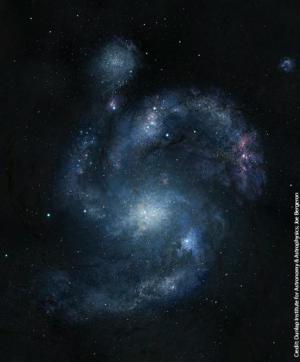Astronomy news
Earliest spiral galaxy ever seen
'should not exist'
13 December 2012
Astronomers have discovered a spiral galaxy in the early universe,
billions of years before spiral galaxies should have formed. In findings
reported in the journal Nature, the astronomers said they
discovered it while studying the properties of about 300 very distant
galaxies in the early universe using the Hubble Space Telescope. This
distant spiral galaxy is being observed as it existed roughly 10.7
billion years ago.
"The fact that this galaxy exists is astounding," said David Law,
lead author of the study. "Current wisdom holds that such 'grand-design'
spiral galaxies simply didn't exist at such an early time in the history
of the universe." A 'grand design' galaxy has prominent, well-formed
spiral arms.
To gain deeper insight into their unique image of the galaxy, which
goes by the not very glamorous name of BX442, the astronomers used the
OSIRIS spectrograph at the Keck Observatory atop Hawaii's dormant Mauna
Kea volcano. They studied spectra from some 3,600 locations in and
around BX442, which enabled them to determine that it actually is a
rotating spiral galaxy, and not, for example, two galaxies that happened
to line up in the image.
"We first thought this could just be an illusion, and that perhaps we
were being led astray by the picture," said Alice Shapley, co-author of
the study. "What we found when we took the spectral image of this galaxy
is that the spiral arms do belong to this galaxy. It wasn't an illusion.
We were blown away."
Why does BX442 look like galaxies that are so common today but are
supposed to be so rare back then? That is the big question.
Shapley will continue to study BX442. "We want to take pictures of
this galaxy at other wavelengths," Shapley said. "That will tell us what
type of stars are in every location in the galaxy. We want to map the
mixture of stars and gas in BX442. Studying BX442 is likely to help
astronomers understand how spiral galaxies like the Milky Way form".
Co-authors are Charles Steidel, the Lee A. DuBridge Professor of
Astronomy at the California Institute of Technology; Naveen Reddy,
assistant professor of physics and astronomy at UC Riverside; and Dawn
Erb, assistant professor of physics at the University of Wisconsin,
Milwaukee. Shapley's research is funded by the David and Lucile Packard
Foundation.

An artist’s rendering of galaxy BX442 and its
companion dwarf galaxy (upper left). (Credit: Dunlap Institute for
Astronomy & Astrophysics/Joe Bergeron)
To top |